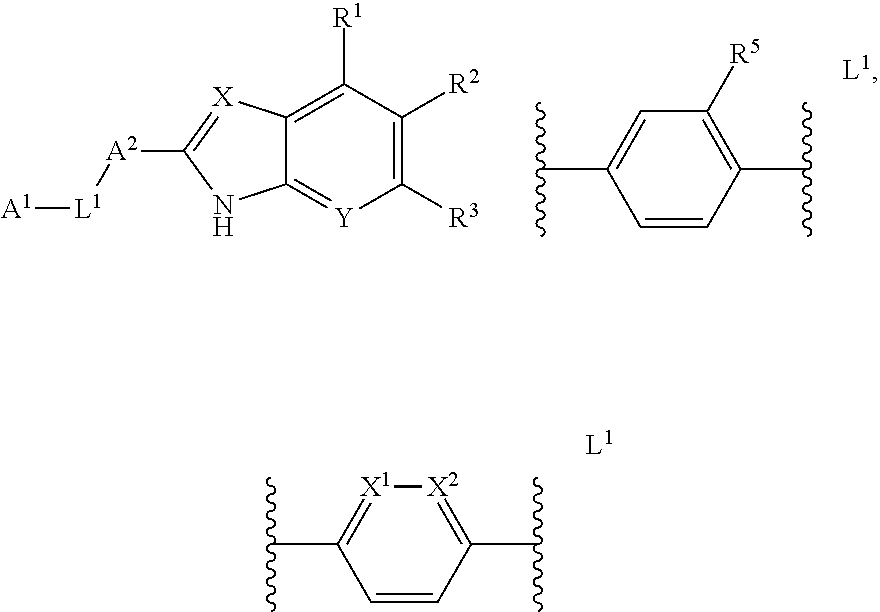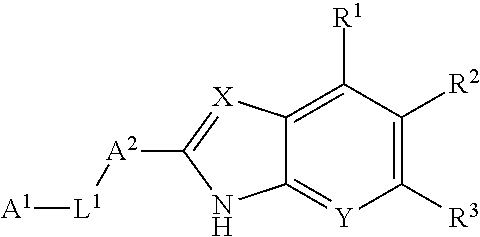2-(hetero)aryl-benzimidazole and imidazopyridine derivatives as inhibitors of asparagime emethyl transferase
a technology of asparagime emethyl transferase and imidazopyridine, which is applied in the direction of blood disorder, extracellular fluid disorder, antineoplastic agent, etc., can solve the problem of elusive mechanisms
- Summary
- Abstract
- Description
- Claims
- Application Information
AI Technical Summary
Benefits of technology
Problems solved by technology
Method used
Image
Examples
example 1
Synthesis of 2-(4-(phenoxymethyl)phenyl)-3H-imidazo[4,5-b]pyridine (1)
[0283]
a) Methyl 4-(phenoxymethyl)benzoate (A3)
[0284]Methyl 4-(bromomethyl)benzoate A2 (0.400 g, 1.75 mmol), DMF (10 mL), phenol A1 (0.181 g, 1.92 mmol) and Cs2CO3 (0.853 g, 2.62 mmol) were stirred at room temperature for 18 hours. The mixture was poured into water (200 mL), stood for 20 minutes and filtered. The collected precipitate was air-dried followed by drying under high vacuum to give the title compound A3 as a white solid (0.386 g, 91%). 1H NMR (400 MHz, d6-DMSO) δ 7.98 (d, J=8.3 Hz, 2H), 7.59 (d, J=8.4 Hz, 2H), 7.34-7.26 (m, 2H), 7.05-6.99 (m, 2H), 6.98-6.92 (m, 1H), 5.20 (s, 2H), 3.85 (s, 3H). LCMS-A rt 6.25 min, m / z (positive ion) 243.1 [M+H]+.
b) 4-(Phenoxymethyl)benzoic acid (A4)
[0285]Methyl 4-(phenoxymethyl)benzoate A3 (0.382 g, 1.58 mmol) was dissolved in THF (12 mL); water (2 mL), MeOH (1 mL) and lithium hydroxide monohydrate (0.264 g, 6.31 mmol) were added. The reaction was stirred at room temperat...
example 2
Synthesis of 2-(4-(benzyloxy)phenyl)-1H-imidazo[4,5-b]pyridine (2)
[0287]
a) 4-(Benzyloxy)benzaldehyde (A8)
[0288]Benzyl bromide A6 (9.9 mL, 83 mmol) was added to a suspension of 4-hydroxybenzaldehyde A7 (10.0 g, 81.9 mmol) and K2CO3 (17.0 g, 122 mmol) in acetonitrile (100 mL). The resulting mixture was stirred vigorously at room temperature for 5 hours. The suspension was filtered and the collected solids were washed with acetonitrile (2×20 mL). The combined filtrates were concentrated in vacuo to give a solid residue which was suspended in petroleum benzine 40-60° C. (100 mL). The solid was collected via filtration, washed with petroleum benzine 40-60° C. (200 mL) and air dried to give the title compound (16 g, 92%) as a white solid. 1H NMR (400 MHz, CDCl3) δ 9.89 (s, 1H), 7.87-7.82 (m, 2H), 7.48-7.34 (m, 5H), 7.12-7.06 (m, 2H), 5.16 (s, 2H).
b) 2-(4-(Benzyloxy)phenyl)-1H-imidazo[4,5-b]pyridine (2)
[0289]A solution of 2-amino-3-nitropyridine A9 (0.066 g, 0.47 mmol) and 4-(benzyloxy)ben...
example 3
Synthesis of N-(4-(3H-imidazo[4,5-b]pyridin-2-yl)phenyl)benzamide (3)
[0290]
a) Methyl 4-benzamidobenzoate (A12)
[0291]To a suspension of methyl 4-aminobenzoate A11 1 (0.600 g, 3.97 mmol) in anhydrous DCM (10 mL) at 0° C. under N2 was added DIPEA (0.761 mL, 0.564 mmol) followed by benzoyl chloride A10 (0.507 mL, 4.37 mmol). The cooling bath was removed and the reaction was stirred overnight, then diluted with DCM (50 mL) and washed with aqueous HCl (2 M, 2×50 mL). The organic phase was dried (MgSO4) and concentrated in vacuo to give the title compound (1.00 g, 99%) as a white solid. 1H NMR (400 MHz, CDCl3) δ 8.07-8.04 (m, 2H), 8.03 (br s, 1H), 7.90-7.84 (m, 2H), 7.77-7.72 (m, 2H), 7.61-7.54 (m, 1H), 7.53-7.47 (m, 2H), 3.91 (s, 3H). LCMS-A rt 5.31 min, m / z (positive ion) 256.2 [M+H]+, m / z (negative ion) 254.1 [M−H]−.
b) 4-Benzamidobenzoic acid (A 13)
[0292]To a solution of methyl 4-benzamidobenzoate A12 (1.00 g, 3.92 mmol) in 4:1:1 v / v THF / MeOH / water (30 mL) was added LiOH—H2O (0.505 g, 1...
PUM
 Login to View More
Login to View More Abstract
Description
Claims
Application Information
 Login to View More
Login to View More - R&D
- Intellectual Property
- Life Sciences
- Materials
- Tech Scout
- Unparalleled Data Quality
- Higher Quality Content
- 60% Fewer Hallucinations
Browse by: Latest US Patents, China's latest patents, Technical Efficacy Thesaurus, Application Domain, Technology Topic, Popular Technical Reports.
© 2025 PatSnap. All rights reserved.Legal|Privacy policy|Modern Slavery Act Transparency Statement|Sitemap|About US| Contact US: help@patsnap.com



